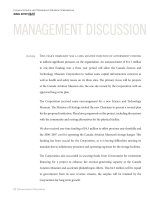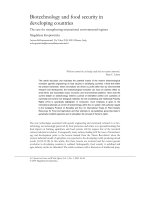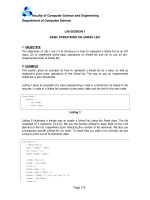science and computers - lec 5
Bạn đang xem bản rút gọn của tài liệu. Xem và tải ngay bản đầy đủ của tài liệu tại đây (31.86 KB, 9 trang )
Lec5
• Nonlinear systems – chaos
• Phase space, Poincare maps, strange at-
tractors
• Period doubling
• Lorenz model, balls in boxes
1
Real pendu lu m
Variables θ(t), ω(t) equation of motion:
dω
dt
= −
g
l
sin (θ) − k
dθ
dt
+ F sin (ω
D
t)
dθ
dt
= ω
Integrate/solve by introducing discrete time t =
ndt, n = 1 . . . and find recurrence relations of
form θ
n+1
= θ
n
+ . . .
Exactly analagous to 1D mot i on with x → θ,
p → ω
Use same code!
(note: θ angle - restrict to −π → π)
2
Simple observations
• Initially transients seen - remnant of decay-
ing natural oscillation
• Small drivi ng force, small amplitude, mo-
tion in step with driving force - like hamr-
monic case
• Larger F – apparently random or chaotic
behavior seen.
• Windows of regular motion found at larger
F !
• Cannot be truly random - motion deter-
ministic. Something more subtle happen-
ing
3
Sensitivity to initial conditions
Two identical pendula with slightly different
initial conditions.
• In regular regime: motions converge with
time
• In chaotic regime : diverge!
• In first case poor knowledge of initial con-
ditions is irrelevant to predicting long ti me
motion
• In other case implies no predictability at
long times (eg. weather )
4
Phase space
Useful to examine moti on not as (t, θ) and
(t, ω) but in phase space (θ, ω).
• Regular (non-chaotic) motion yields simple
closed curve.
• Chaotic motion – much structure. Many
nearly closed orbits, sudden departures to
new orbits, never repeating.
5
Poincare plots
Instead of plotting e nt i re phase space tr ajec-
tory, plot (θ, ω) only at multiples of time period
of driving force.
• For regular motion - single point seen.
• For chaotic motion - non space filling struc-
ture seen. Does not depend on initial con-
ditions
• Predictable aspect of chaotic motion – called
a strange attractor. All chaotic motions of
system approach a motion on the attrac-
tor.
• Not a 1D c urve – in general fractal object
- later.
6
Period doubling
• At F = 1.35 same period as F
• At F = 1.44 we see moti on has twice pe-
riod of driving force
• At F = 1.465 four times driving period T =
T
D
• Continues. Successively smaller increases
in F yield doublings of the period of the
motion. T = ∞ at finite F !
• Period doubling route to chaos seen in many
systems. Furthermore
δ
n
=
F
n
− F
n−1
F
n+1
− F
n
lim
n→∞
= δ ∼ 4.669
Feigenbaum delta
7
Lorenz model
• Another e x ample of model showing chaos.
• (Very)-simplified model of convectiv e fluid
flow – container containing fluid with bot-
tom and top surfaces held at different tem-
peratures.
• Three variables x, y, z corresponding to tem-
perature, density and fluid velocity
• Three parameters σ, r, b (te mperature dif-
ference and fluid parameters)
• Full solution involves Navier-Stokes and very
many variables. Weather simulations etc.
8
Lorenz equations
dx
dt
= σ(y − x)
dy
dt
= −xz + rx − y
dz
dt
= xy − bz
Discretize time and solve as be fore
Set σ = 10.0, b = 8/3. r measures tempera-
ture difference. Analogous to F in pendulum
example.
r = 5 - settles to point - simple convective
flow.
r = 25 - chaos – Lorenz attractor - chaotic or
turbulent flow
9









